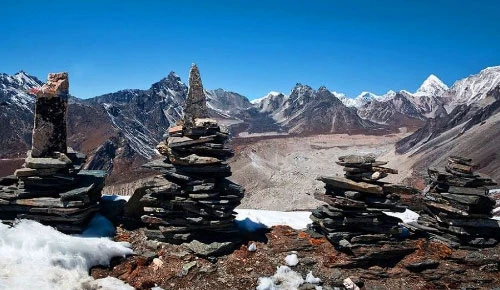Pashupatinath Temple: Nepal's Spiritual Gem
Welcome to the mysterious realm of Pashupatinath Temple, located in Nepal's heart! Here, ancient legends and centuries-old customs merge to provide a spiritual haven.
Pashupatinath Temple has a special place in the hearts of Nepalese and Hindus worldwide. It has a long history and has become an important component of Nepal's cultural heritage. This holy site is more than just a temple; it is a symbol of devotion, faith, and unity.
According to legend, the temple is devoted to Lord Pashupatinath, an admired form of Lord Shiva, the greatest deity in Hinduism. The stories surrounding this temple are captivating, and they have influenced millions of people's beliefs and practices.
You'll be enamored with the temple complex's stunning architecture and sophisticated design as soon as you enter. Each structure has its own meaning that represents the spiritual essence of the location.
Every day, the temple is witness to a variety of rituals and worship. Devotees pray to Lord Pashupatinath, asking for blessings and guidance. The environment is infused with devotion, producing an amazing spiritual experience.
However, the Pashupatinath Temple is more than just a location for ceremonies; it is also a cultural center. It organizes a variety of festivals and events that bring people together to celebrate their common ancestry and traditions.
This sacred place has experienced challenges throughout the years, but dedicated preservation efforts have ensured its survival. Pashupatinath Temple has been declared a UNESCO World Heritage Site, preserving its cultural significance for future generations.
Pashupatinath Temple has become a renowned tourist attraction for visitors from all over the world because of its rich history and mesmerizing environment. However, it is critical to approach the temple with cultural sensitivity and respect, so that its holiness and values are preserved.
In this article, we'll explore the spiritual and cultural significance of Pashupatinath Temple. Join us on the journey to discover the ongoing fascination of Pashupatinath Temple, Nepal's precious treasure. Let's go on this journey together!
| Fact | Description |
|---|---|
| Name | Pashupatinath Temple |
| Location | Kathmandu, Nepal |
| Type | Hindu temple |
| Importance | One of the holiest Hindu temples in Nepal and a UNESCO World Heritage Site |
| Deity | Lord Pashupatinath, a manifestation of Lord Shiva |
| Architecture | Pagoda-style temple with distinctive Nepalese architecture |
| River | Located on the banks of the Bagmati River |
| Cremation Ghats | The temple complex has several cremation ghats along the river for Hindu cremation rituals |
| Bhandara | A large religious fair held annually during Maha Shivaratri, attracting thousands of pilgrims |
| Restrictions | Non-Hindus are not allowed to enter the main temple area |
| Importance to Pilgrims | Considered one of the must-visit pilgrimage sites for Hindus, both from Nepal and India |
| Cultural Significance | Hosts various religious and cultural events throughout the year |
| Damage and Restoration | Affected by the 2015 earthquake, but extensive restoration and reconstruction efforts were undertaken |
| Architecture and Artwork | Adorned with intricate wood carvings, silver and gold plating, and sacred symbols |
| Surrounding Area | The temple complex is surrounded by other smaller temples and ashrams |
| Rituals and Puja | Regular puja (rituals) are conducted by priests and sadhus (holy men) |
| Conservation Efforts | Protected by local authorities and international organizations to preserve its heritage |
| Visit Timings | Open daily with specific visiting hours for tourists and devotees |
| Dress Code | Visitors are required to dress modestly and remove their shoes before entering the temple area |
| Photography | Photography is restricted in certain areas of the temple. Ristricted inside the Main Temple |
Table of Contents
The Legends and Mythology
Nepalese stories and tales have been passed down from generation to generation about the Pashupatinath Temple, and they are very interesting. Lord Pashupatinath is one of the most significant characters in these stories.
Myths from the past say that Lord Pashupatinath is a strong and kind god who is an incarnation of Lord Shiva, one of the most important gods in Hinduism. The name "Pashupatinath" means "Lord of all living beings," which shows that he is in charge of all living things.
One common story about the temple says that the Kathmandu Valley used to be a big lake. People say that Lord Shiva was once a deer and walked around the valley. A group of sages saw the divine deer. They were curious about its strange look, so they followed it into the dense forest. When they finally caught up to the deer, it vanished without a trace, which left them puzzled.
As they kept looking, they found a holy Lingam, which is an abstract symbol of Lord Shiva. When they found out that the deer they had been following was Lord Shiva, they were filled with awe and respect. They quickly built a temple around the Lingam and made Lord Pashupatinath the temple's main god.
Another interesting story is about a religious cowherd called Surya Gopu who used to give his milk every day to a Shiva Lingam that was close by. One day, to his surprise, the milk he gave away started to go away. He was worried about this, so one night he chose to keep watch and saw a young boy sneaking the milk. He was so interested and devoted that he asked the boy who he was, and the boy told him that he was Lord Pashupatinath. From then on, Surya Gopu kept giving milk offerings, and the Lord's divine play became a well-known story.
These fascinating myths and legends are now a big part of Nepalese culture and customs. They help Hindus believe that Lord Pashupatinath is good and will protect them. This makes the temple a very holy place for Hindus. Today, people come from all over the world to visit this holy sanctuary. They come to see its beautiful architecture and to feel the spiritual energy that these old stories have woven into the temple's very existence.
Architecture
The main temple at Pashupatinath is built in a traditional Nepali style called pagoda architecture. It looks stunning with its two levels of roofs made of copper and covered in shiny gold. The whole temple sits on a square platform and reaches an impressive height of 23 meters and 7 centimeters, from the bottom to the very top.
When you approach the temple, you'll notice four main doors, and they're all covered with shiny silver sheets, adding to its beauty. At the very peak of the temple, there's a golden pinnacle that adds a touch of magnificence.
Inside the temple, you'll find two special places called garbhagrihas. The first one is the inner garbhagriha, which is like a private sanctum where the sacred idol is kept. The other one is the outer sanctum, which is more like a corridor with an open space.
The Pashupatinath Temple's architecture is not only visually stunning but also holds great spiritual importance for the people who come to worship and seek blessings here.
Rituals and Worship
Rituals and worship at Pashupatinath Temple are an essential part of the daily lives and spiritual journeys of Hindus in Nepal. These practices have been carried on for centuries, passing down from generation to generation.
Every day, the temple comes alive with devotees who come to pay their respects to Lord Pashupatinath, the presiding deity of the temple. The rituals begin early in the morning with the ringing of bells and the chanting of sacred mantras. The main priests, known as "pundits," perform a variety of ceremonies throughout the day.
One of the most important rituals is the "Abhisheka" ceremony, where the idol of Lord Pashupatinath is bathed with water, milk, yogurt, honey, and ghee. This symbolic act is believed to purify the deity and bring blessings to the devotees. During this time, incense fills the air, and the temple is filled with the sweet fragrance of flowers.
Visitors can also witness the "Aarti" ceremony, which takes place in the evenings. During this ritual, oil lamps are lit, and the pundits wave them in front of the deity while singing devotional songs. The mesmerizing glow of the lamps and the soul-stirring music create a serene and spiritual atmosphere.
Pashupatinath Temple is not only a place for daily rituals but also hosts various festivals throughout the year. The most significant festival celebrated here is Maha Shivaratri, dedicated to Lord Shiva. During this time, the temple is adorned with colorful decorations, and thousands of devotees gather to offer their prayers and seek blessings.
Apart from the priests, pilgrims themselves can perform personal rituals. They offer flowers, fruits, and coconuts to the deity as a token of their devotion. Many also choose to perform a "circumambulation" or "parikrama" around the temple, which involves walking in a clockwise direction as a form of reverence.
The spiritual experience at Pashupatinath Temple is deeply moving and brings a sense of peace and harmony to the devotees' hearts. It is a place where people find solace, seek guidance, and connect with the divine.
Interesting Facts about Pashupatinath Temple
- Pashupatinath Temple, located in Kathmandu, Nepal, is one of the most sacred and revered Hindu temples in the world.
- The temple is dedicated to Lord Pashupatinath, an incarnation of Lord Shiva, who is considered the protector and patron deity of Nepal.
- Pashupatinath is a UNESCO World Heritage Site, recognized for its cultural and religious significance.
- The temple's origins date back to ancient times, with the earliest known records indicating its existence around 400 AD.
- Only Hindus are allowed to enter the main temple premises; however, tourists of all backgrounds can explore the outer areas.
- The main pagoda-style temple is richly ornamented with intricate wood carvings depicting various scenes from Hindu mythology.
- The temple complex spans an area of approximately 264 hectares, making it one of the largest temple complexes in Nepal.
- The Bagmati River, which flows beside the temple, is considered sacred, and Hindus believe that bathing in its waters purifies the soul.
- The temple is a prominent venue for Hindu cremation ceremonies, with traditional funeral pyres burning continuously on the ghats (platforms) along the riverbank.
- There are more than 500 temples and shrines within the Pashupatinath complex, each dedicated to various deities and gods.
- The Maha Shivaratri festival, celebrated annually at Pashupatinath, attracts thousands of devotees who come to offer prayers to Lord Shiva.
- Sadhus (Hindu holy men) from Nepal and India often reside in the temple area, living a life of meditation and asceticism.
- Pashupatinath Temple has survived numerous earthquakes and natural disasters, showcasing the resilience of its architecture.
- The temple's unique silver-plated rooftop is a distinctive feature that catches the eye of visitors.
- It is believed that a visit to Pashupatinath and offering prayers here will bring blessings and fulfillment of one's desires.
- The main entrance of the temple is called the "Western Door," and it is intricately decorated with artistic carvings.
- Non-Hindus can observe the temple's activities from the opposite bank of the Bagmati River, offering a glimpse into the religious practices.
- The main deity, the Pashupatinath Linga, is a naturally occurring rock formation that has been worshipped for centuries.
- Pashupatinath Temple was mentioned in ancient Hindu scriptures like the Puranas and the Mahabharata.
- The temple's stunning architecture, religious significance, and cultural heritage make it a must-visit destination for anyone interested in exploring Nepal's rich spiritual traditions.
Preservation Efforts and UNESCO World Heritage Status
Preserving the Pashupatinath Temple is of utmost importance to protect its rich cultural and historical heritage. Efforts have been made to safeguard this sacred site and ensure its longevity for future generations.
Recognizing its significance, the Pashupatinath Temple has been granted UNESCO World Heritage Status. This prestigious title highlights the temple's global importance and promotes its conservation on an international level.
To maintain the temple's integrity, various preservation initiatives have been put in place. These efforts focus on safeguarding the temple's architecture, sculptures, and cultural traditions. Regular maintenance and restoration work are carried out to protect the temple from the natural elements and wear over time.
Tourism management is also a crucial aspect of preservation. By promoting responsible tourism, visitors are encouraged to respect the temple's sanctity and cultural practices. This helps minimize the impact of tourism on the delicate heritage site.
By working together and recognizing the temple's significance, we can ensure that the Pashupatinath Temple continues to stand as a symbol of Nepal's cultural heritage and spiritual identity for generations to come.
Conclusion
If you are planning to explore the mystique of Pashupatinath Temple and immerse yourself in Nepal's profound spirituality, we offer a one-day Kathmandu City Tour tailor-made to provide you with an unforgettable experience. Our guided tour will take you on a journey through the ancient city, unveiling its hidden gems, historic landmarks, and vibrant culture. With our expert guides, you will witness the spiritual aura of the Pashupatinath Temple firsthand and learn about the rituals and traditions that have shaped Nepal's identity.
In addition to the city tour, we provide other suitable services such as accommodation arrangements, transportation, and assistance with travel logistics. Our aim is to make your trip seamless, allowing you to focus on the spiritual and cultural exploration that Nepal offers.
Come, embark on this enriching pilgrimage to Pashupatinath Temple and discover the awe-inspiring beauty of Nepal's heritage. Let us be your companions on this transformative journey, ensuring you create cherished memories that will last a lifetime.








